 Last Updated February 17, 2017
Last Updated February 17, 2017
The most common Vitamix shopper’s question is some variant of, “I want a Vitamix to make smoothies, soups, and frozen desserts. Which model would be best for me?” The answer is that all Vitamix machines work great for those purposes; which one is best for you depends on whether you want to pay for extra features.
If you don’t want to go through the nitty-gritty, here are my quick Vitamix recommendations:
Which Vitamix model is best?
Certified Reconditioned offers the best value (and now has temporary extra discounts):
- The classic that Vitamix built its reputation on over the past 25 years: 5200 ($299)
- Updated workhorse (my favorite): 7500 ($379).
Want the newest Vitamix with the fanciest features? Check out the Ascent Series:
- All the bells and whistles: A3500
The February 2017 Vitamix shopping landscape
I have continually updated this page as Vitamix has released new models and changed pricing. However, enough has changed that I decided it would be useful to write a new overview. This section is for US shoppers.
I recommend reconditioned deals because Vitamix guarantees Certified Reconditioned machines to be as good as new (and they’re almost always indistinguishable from new). They come with a 5-year warranty and Vitamix’s generous customer support, which includes free two-way shipping for any issue that might arise. The only downside is that they sometimes go out of stock, but as of this writing, they are all available. (With the shift to the new Ascent line, some of these Legacy models might disappear for good.)
 Vitamix dropped the price of the Reconditioned Two Speed ($249). This model has the fewest features of any Vitamix (no variable speed or presets), but it can make almost every Vitamix recipe. Most Vitamix recipes involve blending until things are completely smooth, and the Two Speed works great for that. It has the same power and high-quality container as the more expensive models. Its only weakness is blends where you want to retain texture, like pesto, salsa, chunky soup, and vegetable chopping. It doesn’t give as much control over the consistency, but you can maintain some texture by using low speed and blending in pulses.
Vitamix dropped the price of the Reconditioned Two Speed ($249). This model has the fewest features of any Vitamix (no variable speed or presets), but it can make almost every Vitamix recipe. Most Vitamix recipes involve blending until things are completely smooth, and the Two Speed works great for that. It has the same power and high-quality container as the more expensive models. Its only weakness is blends where you want to retain texture, like pesto, salsa, chunky soup, and vegetable chopping. It doesn’t give as much control over the consistency, but you can maintain some texture by using low speed and blending in pulses.
The Two Speed used to be only slightly less than the Reconditioned 5200, which adds variable speed. For that marginal price difference I generally recommended stepping up to the 5200, but now that it is $50 less, I think the Two Speed is worth some consideration. Most Vitamix owners hardly use the intermediate variable speed settings. The most frequent blend is smoothies, and this machine makes smoothies just as well as any Vitamix model.
The step up is the 5200 ($299). The variable speed adds some versatility. This machine is equivalent to the model that most professional kitchens use. Update: since I wrote part about the Two Speed above, the Two Speed increased by $50 and the 5200 went down by $30, so I think the balances are now tilting back toward the 5200 as the best lower-price option.
 Then there are the 5300 ($360) and 7500 ($379—temporary price reduction!), which use an updated shorter and wider container design. (The 7500 also has an updated “G-Series” base that is slightly quieter and has improved airflow that keeps the motor cooler). The wide container offers some advantages, but it’s not as good at blending small amounts as the narrower containers found on the 5200 and Two Speed. To solve that disadvantage, you can get a secondary small container to go along with the wide container. The wide container plus small container gives the best all-around experience for blending a wide range of volumes. (The 7500 plus 32-oz container has been my set up of choice for the past couple of years.)
Then there are the 5300 ($360) and 7500 ($379—temporary price reduction!), which use an updated shorter and wider container design. (The 7500 also has an updated “G-Series” base that is slightly quieter and has improved airflow that keeps the motor cooler). The wide container offers some advantages, but it’s not as good at blending small amounts as the narrower containers found on the 5200 and Two Speed. To solve that disadvantage, you can get a secondary small container to go along with the wide container. The wide container plus small container gives the best all-around experience for blending a wide range of volumes. (The 7500 plus 32-oz container has been my set up of choice for the past couple of years.)
 Then there’s the newly released Ascent Series. It has some nice features, but nothing that makes the previous models obsolete (see below for more details). The capabilities of the Ascent Series are also currently limited because they do not work with previous Vitamix containers. So you only have the wide container, which doesn’t do as well with small amounts. There are 8-oz and 20-oz containers coming for Ascent in the Spring, but those containers can’t be used with a tamper. (So no small batches of frozen dessert or nut butter.) Also, they use a screw-on blade assembly, which is more annoying to clean than the traditional Vitamix containers. There’s talk of a narrow 48-oz container and a dry blade container for Ascent, but we don’t know how long we’ll have to wait for those containers. If you are excited about the 8-oz and 20-oz containers and don’t mind the price, go for an Ascent model. Otherwise, I recommend considering the previously mentioned Certified Reconditioned models.
Then there’s the newly released Ascent Series. It has some nice features, but nothing that makes the previous models obsolete (see below for more details). The capabilities of the Ascent Series are also currently limited because they do not work with previous Vitamix containers. So you only have the wide container, which doesn’t do as well with small amounts. There are 8-oz and 20-oz containers coming for Ascent in the Spring, but those containers can’t be used with a tamper. (So no small batches of frozen dessert or nut butter.) Also, they use a screw-on blade assembly, which is more annoying to clean than the traditional Vitamix containers. There’s talk of a narrow 48-oz container and a dry blade container for Ascent, but we don’t know how long we’ll have to wait for those containers. If you are excited about the 8-oz and 20-oz containers and don’t mind the price, go for an Ascent model. Otherwise, I recommend considering the previously mentioned Certified Reconditioned models.
 (“+” indicates there are also more expensive options in addition to the price listed in the chart. The following machines are not shown because they do not fit in with the rest: the Vitamix Turboblend Two Speed and Three Speed lack variable speed control, and the Vitamix 5300 and 6500 are a hybrid of the 6300 and 7500—i.e. they have a 7500 container on a 6300 base, without or with presets.)
(“+” indicates there are also more expensive options in addition to the price listed in the chart. The following machines are not shown because they do not fit in with the rest: the Vitamix Turboblend Two Speed and Three Speed lack variable speed control, and the Vitamix 5300 and 6500 are a hybrid of the 6300 and 7500—i.e. they have a 7500 container on a 6300 base, without or with presets.)
 In 2014 Vitamix released the Vitamix S30. It is smaller than the other Vitamix models, and also comes with a combination blending container/to-go smoothie cup. The Vitamix S50 and Vitamix S55 came out in 2015, and they are the same as the S30 but add preset modes. Since these models are significantly different from all the other models, If you are considering a smaller blender, or like the idea of blending in a to-go smoothie cup, you should check them out. Not surprisingly, the S-Series’ smaller size means that their maximum capacity is lower the other models (40 oz vs 64 oz).
In 2014 Vitamix released the Vitamix S30. It is smaller than the other Vitamix models, and also comes with a combination blending container/to-go smoothie cup. The Vitamix S50 and Vitamix S55 came out in 2015, and they are the same as the S30 but add preset modes. Since these models are significantly different from all the other models, If you are considering a smaller blender, or like the idea of blending in a to-go smoothie cup, you should check them out. Not surprisingly, the S-Series’ smaller size means that their maximum capacity is lower the other models (40 oz vs 64 oz).
 The variable speed control found on all Vitamix machines except for the Two Speed and 6000 is useful for when you don’t want to fully liquefy your blend. Examples are pesto, salsa, or chopping vegetables. If you don’t have variable speed, you can get away with quickly pulsing, but you won’t have quite as much control. The variable speed also makes the “bubble removal trick” more effective, although pulsing on low speed also works.
The variable speed control found on all Vitamix machines except for the Two Speed and 6000 is useful for when you don’t want to fully liquefy your blend. Examples are pesto, salsa, or chopping vegetables. If you don’t have variable speed, you can get away with quickly pulsing, but you won’t have quite as much control. The variable speed also makes the “bubble removal trick” more effective, although pulsing on low speed also works.
 The preset programs on the 6000, 6300/Pro 500, S55, and Pro 750 allow you to select a program, turn it on, and then the machine will automatically ramp up the speed and then shut off after a certain amount of time. There are a number of reasons that people appreciate this function:
The preset programs on the 6000, 6300/Pro 500, S55, and Pro 750 allow you to select a program, turn it on, and then the machine will automatically ramp up the speed and then shut off after a certain amount of time. There are a number of reasons that people appreciate this function:
• You can start the machine and “walk away” to do something else.
• If you strictly follow recipes the presets can yield more consistent results.
• Presets can give new users more confidence with the machine.
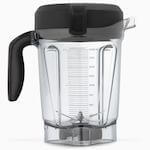 Vitamix released the “Next Generation,” aka “G-Series,” models in 2012. Both the base and the pitcher have an updated design. The base has slightly better sound muffling and also has better airflow which means that it can work harder before it overheats. To go with the better-cooled motor, the updated pitcher has a 4-inch blade instead of the Standard/Classic “C-Series” 3-inch blade. The 4-inch blade is in a shorter and wider container that has the same capacity as the 64-oz C-Series container.
Vitamix released the “Next Generation,” aka “G-Series,” models in 2012. Both the base and the pitcher have an updated design. The base has slightly better sound muffling and also has better airflow which means that it can work harder before it overheats. To go with the better-cooled motor, the updated pitcher has a 4-inch blade instead of the Standard/Classic “C-Series” 3-inch blade. The 4-inch blade is in a shorter and wider container that has the same capacity as the 64-oz C-Series container.
 Buying reconditioned is a great way to save money.
Buying reconditioned is a great way to save money.
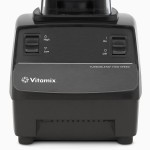 TurboBlend Two Speed ($399); reconditioned for $283. This machine comes with a 5-year warranty and lacks the variable speed knob. Variable speed is useful for cases where you want to have finer control over the texture (i.e. if you don’t want a totally smooth purée). However, you can accomplish some non-liquefying chopping tasks by quickly pulsing the machine. While this is the most affordable new machine, I’d highly recommend looking at the reconditioned 5200, which has the same warranty and adds variable speed for $70 less.
TurboBlend Two Speed ($399); reconditioned for $283. This machine comes with a 5-year warranty and lacks the variable speed knob. Variable speed is useful for cases where you want to have finer control over the texture (i.e. if you don’t want a totally smooth purée). However, you can accomplish some non-liquefying chopping tasks by quickly pulsing the machine. While this is the most affordable new machine, I’d highly recommend looking at the reconditioned 5200, which has the same warranty and adds variable speed for $70 less.
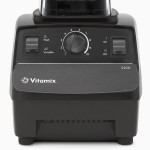 Until recently this was Vitamix’s bread and butter, and they have a lot of models to show for it: 5200 ($499), TurboBlend VS (retired), CIA Pro (retired), Pro 200 ($499), Creations II ($449), and Creations GC (retired); reconditioned for $329. These machines are essentially identical. Some are available with a shorter 48-oz container instead of the 64-oz container. The smaller container is nice because it’s more compact (and fits under standard kitchen cabinets), but of course its capacity is lower. The aesthetics of the switches and dial are slightly different between the different models. The Creations models come with a 5-year warranty, while the rest are 7 years. The 5200 comes with their “whole foods cookbook,” the TurboBlend VS comes with a vegetarian/vegan/raw cookbook and a nutmilk straining bag, the Pro models come with a cookbook with restaurant-oriented recipes (the CIA one—that’s Culinary Institute of America—comes with an additional recipe book). In my opinion the best Vitamix bang for the buck is the $329 reconditioned Standard, which comes with a 5-year warranty and brand new container/tamper. Note that if you buy reconditioned, you cannot choose which of the Standard models you are getting; Vitamix will choose for you based on availability, but remember that functionally they are identical.
Until recently this was Vitamix’s bread and butter, and they have a lot of models to show for it: 5200 ($499), TurboBlend VS (retired), CIA Pro (retired), Pro 200 ($499), Creations II ($449), and Creations GC (retired); reconditioned for $329. These machines are essentially identical. Some are available with a shorter 48-oz container instead of the 64-oz container. The smaller container is nice because it’s more compact (and fits under standard kitchen cabinets), but of course its capacity is lower. The aesthetics of the switches and dial are slightly different between the different models. The Creations models come with a 5-year warranty, while the rest are 7 years. The 5200 comes with their “whole foods cookbook,” the TurboBlend VS comes with a vegetarian/vegan/raw cookbook and a nutmilk straining bag, the Pro models come with a cookbook with restaurant-oriented recipes (the CIA one—that’s Culinary Institute of America—comes with an additional recipe book). In my opinion the best Vitamix bang for the buck is the $329 reconditioned Standard, which comes with a 5-year warranty and brand new container/tamper. Note that if you buy reconditioned, you cannot choose which of the Standard models you are getting; Vitamix will choose for you based on availability, but remember that functionally they are identical.
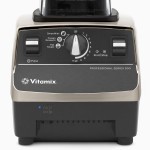 Pro 500 ($559) and 6300 (retired); reconditioned for $379. These are the same model; the only difference is that the 6300 comes with the “Savor” cookbook, which has a broader range of recipes than the Pro 500’s “Create” cookbook, which focuses more on restaurant-style recipes that tend to be richer.) They have 3 preset programs that run the blender for a certain amount of time and speed for smoothies, frozen desserts, and hot soups. Their switches are slightly different from the non-preset models. The non-preset models have an on-off switch, a variable speed knob, and a high-variable speed switch. The preset ones have moved the highest speed setting onto the knob and replaced the high-variable speed switch with a pulse switch. This is really a minor aesthetic difference, since you can achieve pulsing on the non-preset models by quickly flicking the on-off switch on and off.
Pro 500 ($559) and 6300 (retired); reconditioned for $379. These are the same model; the only difference is that the 6300 comes with the “Savor” cookbook, which has a broader range of recipes than the Pro 500’s “Create” cookbook, which focuses more on restaurant-style recipes that tend to be richer.) They have 3 preset programs that run the blender for a certain amount of time and speed for smoothies, frozen desserts, and hot soups. Their switches are slightly different from the non-preset models. The non-preset models have an on-off switch, a variable speed knob, and a high-variable speed switch. The preset ones have moved the highest speed setting onto the knob and replaced the high-variable speed switch with a pulse switch. This is really a minor aesthetic difference, since you can achieve pulsing on the non-preset models by quickly flicking the on-off switch on and off.
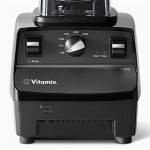 6000 (retired). Released October 2013, this is more of a mash-up of existing machines than a truly new one. It’s a sort of blend between the Two Speed, and the 6300. It does not have variable speed control, but it has six preset timed blending settings. These settings will automatically ramp up the speed, and then turn it off after a specified time of 20 sec, 30 sec, 1 min, 1.5 min, 4.5 min, or 6.5 min. Like the 6300, the pulse control is spring-loaded so that it only stays on as long as you hold it down, and it blends at a medium-low speed.
6000 (retired). Released October 2013, this is more of a mash-up of existing machines than a truly new one. It’s a sort of blend between the Two Speed, and the 6300. It does not have variable speed control, but it has six preset timed blending settings. These settings will automatically ramp up the speed, and then turn it off after a specified time of 20 sec, 30 sec, 1 min, 1.5 min, 4.5 min, or 6.5 min. Like the 6300, the pulse control is spring-loaded so that it only stays on as long as you hold it down, and it blends at a medium-low speed.
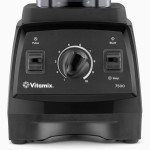 7500 ($529–$549), Creations Elite ($557.50), and Pro 300 ($559). These are all the same machine, but the Creations Elite comes with a 48-oz, 3-inch-blade container, while the other two come with the new-style 64-oz 4-inch-blade container. (The Vitamix.com specs for the Creations Elite have a typo: they say it has a 4-inch blade, but it really has a 3-inch blade.) The Creations Elite also comes with a 5-year instead of 7-year warranty.
7500 ($529–$549), Creations Elite ($557.50), and Pro 300 ($559). These are all the same machine, but the Creations Elite comes with a 48-oz, 3-inch-blade container, while the other two come with the new-style 64-oz 4-inch-blade container. (The Vitamix.com specs for the Creations Elite have a typo: they say it has a 4-inch blade, but it really has a 3-inch blade.) The Creations Elite also comes with a 5-year instead of 7-year warranty.
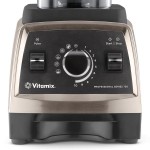
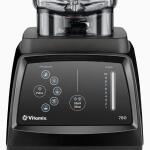 Pro 750 ($649–$699), 780 ($749). These models have 5 presets: smoothies, frozen desserts, purées, hot soups, and self-washing. If you want to see more details of exactly what the presets do, check out this page about demystifying Vitamix presets. The 780 has a newly-released touchpanel interface, which, combined with the smooth styling of the G-Series base, makes it the most futuristic-looking Vitamix. See my Vitamix 780 review for more details.
Pro 750 ($649–$699), 780 ($749). These models have 5 presets: smoothies, frozen desserts, purées, hot soups, and self-washing. If you want to see more details of exactly what the presets do, check out this page about demystifying Vitamix presets. The 780 has a newly-released touchpanel interface, which, combined with the smooth styling of the G-Series base, makes it the most futuristic-looking Vitamix. See my Vitamix 780 review for more details.
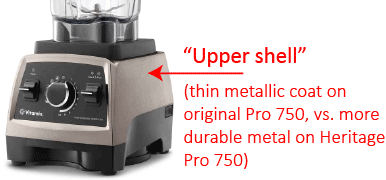 The original 750 came in a brushed stainless finish option, but the upper shell was plastic with a thin metallic coat that could be scratched or scuffed. (When I tested the original 750 for a couple of months, I did not see any problems, but I have heard that some people have noticed scratches/scuffs.) The solid metal of the new Heritage models is more durable. Also, the metal shell muffles the the motor a bit more than the plastic, making the Heritage models a bit quieter.
The original 750 came in a brushed stainless finish option, but the upper shell was plastic with a thin metallic coat that could be scratched or scuffed. (When I tested the original 750 for a couple of months, I did not see any problems, but I have heard that some people have noticed scratches/scuffs.) The solid metal of the new Heritage models is more durable. Also, the metal shell muffles the the motor a bit more than the plastic, making the Heritage models a bit quieter.
 The other minor difference is that the Heritage models’ front panel has fewer backlights: Heritage models light up the indicators above the pulse and start-stop switches, whereas the original Pro 750 has backlights around the central knob as well.
The other minor difference is that the Heritage models’ front panel has fewer backlights: Heritage models light up the indicators above the pulse and start-stop switches, whereas the original Pro 750 has backlights around the central knob as well.
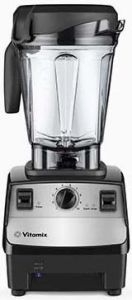 5300 ($529) and 6500 ($599). Vitamix does not sell the new models online, only the reconditioned one. These are “new” models for 2015, although they are actually just slightly unexpected mash-ups of previous models. They are a hybrid between a 6300 and a 7500. They use the wide Next Gen (G-Series) container but they have a Classic (C-Series) base. The 5300 has variable speed and a pulse control switch, and has no presets. Meanwhile, the 6500 has the same three presets as the 6300.
5300 ($529) and 6500 ($599). Vitamix does not sell the new models online, only the reconditioned one. These are “new” models for 2015, although they are actually just slightly unexpected mash-ups of previous models. They are a hybrid between a 6300 and a 7500. They use the wide Next Gen (G-Series) container but they have a Classic (C-Series) base. The 5300 has variable speed and a pulse control switch, and has no presets. Meanwhile, the 6500 has the same three presets as the 6300.
 I know I already mentioned reconditioned machines, but I want to restate what a great deal I think they are. These factory-refurbished machines offer the best prices you’ll find on Vitamix: 2-Speed for $249, S30 for $249, 5200 for
I know I already mentioned reconditioned machines, but I want to restate what a great deal I think they are. These factory-refurbished machines offer the best prices you’ll find on Vitamix: 2-Speed for $249, S30 for $249, 5200 for
$329$299
$429$379, and Pro 750 for $
 Then there are the 5300 ($360) and 7500 ($379—temporary price reduction!), which use an updated shorter and wider container design. (The 7500 also has an updated “G-Series” base that is slightly quieter and has improved airflow that keeps the motor cooler). The wide container offers some advantages, but it’s not as good at blending small amounts as the narrower containers found on the 5200 and Two Speed. To solve that disadvantage, you can get a secondary small container to go along with the wide container. The wide container plus small container gives the best all-around experience for blending a wide range of volumes. (The 7500 plus 32-oz container has been my set up of choice for the past couple of years.)
Then there are the 5300 ($360) and 7500 ($379—temporary price reduction!), which use an updated shorter and wider container design. (The 7500 also has an updated “G-Series” base that is slightly quieter and has improved airflow that keeps the motor cooler). The wide container offers some advantages, but it’s not as good at blending small amounts as the narrower containers found on the 5200 and Two Speed. To solve that disadvantage, you can get a secondary small container to go along with the wide container. The wide container plus small container gives the best all-around experience for blending a wide range of volumes. (The 7500 plus 32-oz container has been my set up of choice for the past couple of years.)
I personally don’t use presets, but plenty of people love them. If you want presets, you can get them with a Classic-style machine ($379), or with the updated G-Series wide-container style ($519).
 Then there’s the newly released Ascent Series. It has some nice features, but nothing that makes the previous models obsolete (see below for more details). The capabilities of the Ascent Series are also currently limited because they do not work with previous Vitamix containers. So you only have the wide container, which doesn’t do as well with small amounts. There are 8-oz and 20-oz containers coming for Ascent in the Spring, but those containers can’t be used with a tamper. (So no small batches of frozen dessert or nut butter.) Also, they use a screw-on blade assembly, which is more annoying to clean than the traditional Vitamix containers. There’s talk of a narrow 48-oz container and a dry blade container for Ascent, but we don’t know how long we’ll have to wait for those containers. If you are excited about the 8-oz and 20-oz containers and don’t mind the price, go for an Ascent model. Otherwise, I recommend considering the previously mentioned Certified Reconditioned models.
Then there’s the newly released Ascent Series. It has some nice features, but nothing that makes the previous models obsolete (see below for more details). The capabilities of the Ascent Series are also currently limited because they do not work with previous Vitamix containers. So you only have the wide container, which doesn’t do as well with small amounts. There are 8-oz and 20-oz containers coming for Ascent in the Spring, but those containers can’t be used with a tamper. (So no small batches of frozen dessert or nut butter.) Also, they use a screw-on blade assembly, which is more annoying to clean than the traditional Vitamix containers. There’s talk of a narrow 48-oz container and a dry blade container for Ascent, but we don’t know how long we’ll have to wait for those containers. If you are excited about the 8-oz and 20-oz containers and don’t mind the price, go for an Ascent model. Otherwise, I recommend considering the previously mentioned Certified Reconditioned models.
For the month of February, Vitamix is offering a free starter kit with most new machine purchases and the Reconditioned 7500 (excludes Turboblend Two Speed and Reconditioned other than the 7500). The kit has a filtration bag, fresh ingredients for 5 recipes, and a $20 GreenBlender giftcard for future GreenBlender boxes.
Comparison of pre-Ascent models follows
If you want to quickly see the relation between all of the different Vitamix models, you can jump ahead to my below comparison chart.
I made an interactive tool to help explore the different features. Try playing with it to get a sense of which you are interested in. You can click any model to go to its Vitamix.com page, or you can read more about the different models below.
If you’re overwhelmed by the choices and just want to know my preference, I’ve used all of the different types of Vitamix blenders, and the one I use on a daily basis is the 7500, with an extra 32-oz container for blending smaller amounts. (For the best deal, check out certified reconditioned.) All of the models are excellent, and I don’t think there is a wrong choice.
Summary of Differences
These are the five key decisions to make when deciding which Vitamix to buy:
- Personal Blender?
- Variable Speed?
- Preset Programs?
- C-Series or G-Series?
- Reconditioned?
The following comparison chart shows the relations between the different machines in the S-Series, C-Series, and G-Series. The machines within most boxes of the chart are identical, but they come with different accessories and cookbooks (the exceptions are the S50 and S55, where the S55 has 2 more presets than the S50, and the Pro 750 and Vitamix 780, where the 780 has a flat touchpanel control). Generally the differences in accessories/cookbooks are pretty marginal, so I’d recommend going for the lowest price model within the box.
 (“+” indicates there are also more expensive options in addition to the price listed in the chart. The following machines are not shown because they do not fit in with the rest: the Vitamix Turboblend Two Speed and Three Speed lack variable speed control, and the Vitamix 5300 and 6500 are a hybrid of the 6300 and 7500—i.e. they have a 7500 container on a 6300 base, without or with presets.)
(“+” indicates there are also more expensive options in addition to the price listed in the chart. The following machines are not shown because they do not fit in with the rest: the Vitamix Turboblend Two Speed and Three Speed lack variable speed control, and the Vitamix 5300 and 6500 are a hybrid of the 6300 and 7500—i.e. they have a 7500 container on a 6300 base, without or with presets.)Personal Blender? (S-Series vs. C-Series and G-Series)
(Vitamix S30 and S55 vs. 5200, 7500, et al.)
 In 2014 Vitamix released the Vitamix S30. It is smaller than the other Vitamix models, and also comes with a combination blending container/to-go smoothie cup. The Vitamix S50 and Vitamix S55 came out in 2015, and they are the same as the S30 but add preset modes. Since these models are significantly different from all the other models, If you are considering a smaller blender, or like the idea of blending in a to-go smoothie cup, you should check them out. Not surprisingly, the S-Series’ smaller size means that their maximum capacity is lower the other models (40 oz vs 64 oz).
In 2014 Vitamix released the Vitamix S30. It is smaller than the other Vitamix models, and also comes with a combination blending container/to-go smoothie cup. The Vitamix S50 and Vitamix S55 came out in 2015, and they are the same as the S30 but add preset modes. Since these models are significantly different from all the other models, If you are considering a smaller blender, or like the idea of blending in a to-go smoothie cup, you should check them out. Not surprisingly, the S-Series’ smaller size means that their maximum capacity is lower the other models (40 oz vs 64 oz).Variable Speed?
(Vitamix Two Speed vs. 5200 and Vitamix 6000 vs. 6300)
 The variable speed control found on all Vitamix machines except for the Two Speed and 6000 is useful for when you don’t want to fully liquefy your blend. Examples are pesto, salsa, or chopping vegetables. If you don’t have variable speed, you can get away with quickly pulsing, but you won’t have quite as much control. The variable speed also makes the “bubble removal trick” more effective, although pulsing on low speed also works.
The variable speed control found on all Vitamix machines except for the Two Speed and 6000 is useful for when you don’t want to fully liquefy your blend. Examples are pesto, salsa, or chopping vegetables. If you don’t have variable speed, you can get away with quickly pulsing, but you won’t have quite as much control. The variable speed also makes the “bubble removal trick” more effective, although pulsing on low speed also works.Preset Programs?
(Vitamix Two Speed vs. 6000, Vitamix 5200 vs. 6300, Vitamix Professional Series 200 vs. Professional Series 500, Vitamix S30 vs. S55, and Vitamix Professional Series 300 vs. Professional Series 750)
 The preset programs on the 6000, 6300/Pro 500, S55, and Pro 750 allow you to select a program, turn it on, and then the machine will automatically ramp up the speed and then shut off after a certain amount of time. There are a number of reasons that people appreciate this function:
The preset programs on the 6000, 6300/Pro 500, S55, and Pro 750 allow you to select a program, turn it on, and then the machine will automatically ramp up the speed and then shut off after a certain amount of time. There are a number of reasons that people appreciate this function:• You can start the machine and “walk away” to do something else.
• If you strictly follow recipes the presets can yield more consistent results.
• Presets can give new users more confidence with the machine.
However, the presets do not work perfectly every time. Sometimes ingredients require tamping to start circulating past the blades, so you can’t always “walk away.” Also, the preset time might not be the optimum blending time if you modify a recipe. You may find that your smoothie is not fully blended after the smoothie program runs, so you have to run it again. A commercial coffee or smoothie shop makes the same recipes over and over, so in that setting presets are extremely useful. If you constantly make new combinations and of differing amounts, as many home users do, the settings may be less useful. It’s not too hard to tell when something is sufficiently blended, and after a few trials anyone should be able to figure it out. For these reasons, I personally would not pay extra for the preset settings. However, I know many people who have the presets love them. One thing to remember is that the machines with presets still have the variable speed knob for full manual control. If you don’t mind the added cost of presets, you can always switch back and forth to manual control.
C-Series vs. G-Series (Next Generation)?
(Vitamix 5200 vs. 7500, and Vitamix Professional Series 500 vs. Professional Series 750)
 Vitamix released the “Next Generation,” aka “G-Series,” models in 2012. Both the base and the pitcher have an updated design. The base has slightly better sound muffling and also has better airflow which means that it can work harder before it overheats. To go with the better-cooled motor, the updated pitcher has a 4-inch blade instead of the Standard/Classic “C-Series” 3-inch blade. The 4-inch blade is in a shorter and wider container that has the same capacity as the 64-oz C-Series container.
Vitamix released the “Next Generation,” aka “G-Series,” models in 2012. Both the base and the pitcher have an updated design. The base has slightly better sound muffling and also has better airflow which means that it can work harder before it overheats. To go with the better-cooled motor, the updated pitcher has a 4-inch blade instead of the Standard/Classic “C-Series” 3-inch blade. The 4-inch blade is in a shorter and wider container that has the same capacity as the 64-oz C-Series container.
Advantages of the wider design:
• less need for the tamper (ingredients fall into the blades more easily)
• better chopping capability (you can course-chop more ingredients at a time)
• easier to scrape thick mixtures out
Advantage of shorter design:
• easier storage (at 17.5” tall, the container with lid on the base fits under standard kitchen cabinets)
Advantages of the 4-inch blade:
• faster processing time
• under some circumstances, marginally smoother blends
• less need for the tamper (ingredients fall into the blades more easily)
• better chopping capability (you can course-chop more ingredients at a time)
• easier to scrape thick mixtures out
Advantage of shorter design:
• easier storage (at 17.5” tall, the container with lid on the base fits under standard kitchen cabinets)
Advantages of the 4-inch blade:
• faster processing time
• under some circumstances, marginally smoother blends
The one disadvantage of the new container is that for small volumes of under ~2 cups it does not work quite as well as the C-Series narrow container. The G-Series wider design causes two things to happen. First, there is more splashing up onto the inside of the lid and upper walls of the container, which means you lose a small amount of your blend unless you carefully scrape off the lid and walls. Second, you need slightly more volume to cover the blades and get good circulation going. The minimum volume to blend depends on what you are blending, and also on how much effort you are willing to spend pushing ingredients back into the blades. For example, for best results, the narrow containers can make nut butter easily by starting with 3 cups of nuts, whereas the wider Next Generation containers do best with 4 cups of nuts. For easier, more liquidy, blends, you can go below 1 cup in either container, but Next Generation containers will splash around more.
This disadvantage is a non-issue if most of your blends are over 2 cups, or if you are willing to spend a bit more to buy an additional narrow container, which will give you the best of both worlds. I like the 32-oz container for this purpose, although the 48-oz container has the same narrow bottom so it works just as well. The 48-oz container is just a bit bulkier on the outside because it sits outside the centering posts instead of inside of them, and its top is wider as well.
(The narrow C-Series Vitamix containers are compatible with G-Series models, but the G-Series containers are not recommended for use on C-Series models. The longer G-Series blades increase the load, and Vitamix does not recommend the C-Series cooling system for those increased loads.)
Reconditioned?
 Buying reconditioned is a great way to save money.
Buying reconditioned is a great way to save money. Continue on for more details of each model type…
The array of different Vitamix blenders is a bit confusing, but it turns out that there is a lot of redundancy between the different models. I am only discussing models made for consumer/home use. Their commercial blenders are not ideal for home use because they are generally more expensive and have shorter warranties (3 years vs 7 years for home use; they are warrantied for constant use—think of how many times per day a blender at Jamba Juice runs compared to at your home).
The Vitamix website currently lists over 30 different home models, but they are all variants of three main designs: “personal” (S-Series), “standard/classic” (C-Series), and “next generation” (G-Series). For each of these main designs there are a few different options, to make a total of 8 different machine types. The rest of the models have identical bases, but come with different containers and/or accessories.
S-Series Motors
If the smaller size, dishwasher safe container, and “to-go” blending container appeal to you, please read the full details at my Vitamix S30, S50, and S55 review. For quick reference, the size of the base is 8.3″ deep x 5.9″ wide x 7.7″ tall. With the 20-oz to-go container the total height is 14.55″. The height is 15.66″ with the 40-oz container. These models have lower power, but they are still capable of making all of the usual Vitamix creations, just in smaller quantities.
C-Series Motors (Standard/Classic)
There are three types of bases of the standard variety. The differences are in the controls. The dimensions of the base of these machines are 8.75″ deep x 7.25″ wide x 8.25″ tall. There are three different container size options: 32 oz, 48 oz, and 64 oz, which result in height of base plus container/lid of 16.9″, 17.4″, and 20.5″ respectively.
Standard, no-variable speed (Vitamix TurboBlend Two Speed and Three Speed)
 TurboBlend Two Speed ($399); reconditioned for $283. This machine comes with a 5-year warranty and lacks the variable speed knob. Variable speed is useful for cases where you want to have finer control over the texture (i.e. if you don’t want a totally smooth purée). However, you can accomplish some non-liquefying chopping tasks by quickly pulsing the machine. While this is the most affordable new machine, I’d highly recommend looking at the reconditioned 5200, which has the same warranty and adds variable speed for $70 less.
TurboBlend Two Speed ($399); reconditioned for $283. This machine comes with a 5-year warranty and lacks the variable speed knob. Variable speed is useful for cases where you want to have finer control over the texture (i.e. if you don’t want a totally smooth purée). However, you can accomplish some non-liquefying chopping tasks by quickly pulsing the machine. While this is the most affordable new machine, I’d highly recommend looking at the reconditioned 5200, which has the same warranty and adds variable speed for $70 less.
In May 2016 Vitamix came out with a new no-variable speed machine, the TurboBlend Three Speed($499). It is exactly what it sounds like: it has three speed settings: low, medium, and high. It also has a pulse switch, which does the same thing as switching the start-stop button on and off. The pricing on this model is a bit strange, since for $50 less you can get a machine with fully variable speed. Plus, the TurboBlend 3-Speed comes with a 5-year warranty, instead of the 7 years on machines like the 5200.
Standard variable speed (Vitamix 5200 et al.)
 Until recently this was Vitamix’s bread and butter, and they have a lot of models to show for it: 5200 ($499), TurboBlend VS (retired), CIA Pro (retired), Pro 200 ($499), Creations II ($449), and Creations GC (retired); reconditioned for $329. These machines are essentially identical. Some are available with a shorter 48-oz container instead of the 64-oz container. The smaller container is nice because it’s more compact (and fits under standard kitchen cabinets), but of course its capacity is lower. The aesthetics of the switches and dial are slightly different between the different models. The Creations models come with a 5-year warranty, while the rest are 7 years. The 5200 comes with their “whole foods cookbook,” the TurboBlend VS comes with a vegetarian/vegan/raw cookbook and a nutmilk straining bag, the Pro models come with a cookbook with restaurant-oriented recipes (the CIA one—that’s Culinary Institute of America—comes with an additional recipe book). In my opinion the best Vitamix bang for the buck is the $329 reconditioned Standard, which comes with a 5-year warranty and brand new container/tamper. Note that if you buy reconditioned, you cannot choose which of the Standard models you are getting; Vitamix will choose for you based on availability, but remember that functionally they are identical.
Until recently this was Vitamix’s bread and butter, and they have a lot of models to show for it: 5200 ($499), TurboBlend VS (retired), CIA Pro (retired), Pro 200 ($499), Creations II ($449), and Creations GC (retired); reconditioned for $329. These machines are essentially identical. Some are available with a shorter 48-oz container instead of the 64-oz container. The smaller container is nice because it’s more compact (and fits under standard kitchen cabinets), but of course its capacity is lower. The aesthetics of the switches and dial are slightly different between the different models. The Creations models come with a 5-year warranty, while the rest are 7 years. The 5200 comes with their “whole foods cookbook,” the TurboBlend VS comes with a vegetarian/vegan/raw cookbook and a nutmilk straining bag, the Pro models come with a cookbook with restaurant-oriented recipes (the CIA one—that’s Culinary Institute of America—comes with an additional recipe book). In my opinion the best Vitamix bang for the buck is the $329 reconditioned Standard, which comes with a 5-year warranty and brand new container/tamper. Note that if you buy reconditioned, you cannot choose which of the Standard models you are getting; Vitamix will choose for you based on availability, but remember that functionally they are identical.
Sometimes these models are listed with their color-specific SKU. All of the following models are identical to the 5200, they just come with different colors and names: Vitamix 1709, 1363, 1364, 1365, 1709, 1723, 1732. They also sometimes go by VM0103. Vitamix 1978 is also the same, but comes with a 48-oz container.
Standard variable speed + presets (Vitamix 6300 and Professional Series 500)
 Pro 500 ($559) and 6300 (retired); reconditioned for $379. These are the same model; the only difference is that the 6300 comes with the “Savor” cookbook, which has a broader range of recipes than the Pro 500’s “Create” cookbook, which focuses more on restaurant-style recipes that tend to be richer.) They have 3 preset programs that run the blender for a certain amount of time and speed for smoothies, frozen desserts, and hot soups. Their switches are slightly different from the non-preset models. The non-preset models have an on-off switch, a variable speed knob, and a high-variable speed switch. The preset ones have moved the highest speed setting onto the knob and replaced the high-variable speed switch with a pulse switch. This is really a minor aesthetic difference, since you can achieve pulsing on the non-preset models by quickly flicking the on-off switch on and off.
Pro 500 ($559) and 6300 (retired); reconditioned for $379. These are the same model; the only difference is that the 6300 comes with the “Savor” cookbook, which has a broader range of recipes than the Pro 500’s “Create” cookbook, which focuses more on restaurant-style recipes that tend to be richer.) They have 3 preset programs that run the blender for a certain amount of time and speed for smoothies, frozen desserts, and hot soups. Their switches are slightly different from the non-preset models. The non-preset models have an on-off switch, a variable speed knob, and a high-variable speed switch. The preset ones have moved the highest speed setting onto the knob and replaced the high-variable speed switch with a pulse switch. This is really a minor aesthetic difference, since you can achieve pulsing on the non-preset models by quickly flicking the on-off switch on and off.
Some people love the presets because you can set it and walk away (assuming the mixture is circulating and you don’t need the tamper), and because they get more consistent results. However, the more consistent results will only hold if you always add the same quantities and types of items to the blender. For example, if you’re making a small smoothie, you can blend it for less time than if you were making a large one. One other thing is that you can set the non-preset machines and walk away—you just have to come back to stop them. I often use the blending time to rinse off the knife and cutting board that I used. You’re not likely to forget that the Vitamix is running because it’s loud enough to hear throughout the house. The variable speed knob goes to the same high speed as the previous models on high, but it’s lowest setting is a bit faster than on the 5200 et al., so you lose a tiny bit of fine control. Whether the presets are worth it is a personal question—I wouldn’t pay extra for them, but some people love them.
Standard no variable speed + presets (Vitamix 6000)
 6000 (retired). Released October 2013, this is more of a mash-up of existing machines than a truly new one. It’s a sort of blend between the Two Speed, and the 6300. It does not have variable speed control, but it has six preset timed blending settings. These settings will automatically ramp up the speed, and then turn it off after a specified time of 20 sec, 30 sec, 1 min, 1.5 min, 4.5 min, or 6.5 min. Like the 6300, the pulse control is spring-loaded so that it only stays on as long as you hold it down, and it blends at a medium-low speed.
6000 (retired). Released October 2013, this is more of a mash-up of existing machines than a truly new one. It’s a sort of blend between the Two Speed, and the 6300. It does not have variable speed control, but it has six preset timed blending settings. These settings will automatically ramp up the speed, and then turn it off after a specified time of 20 sec, 30 sec, 1 min, 1.5 min, 4.5 min, or 6.5 min. Like the 6300, the pulse control is spring-loaded so that it only stays on as long as you hold it down, and it blends at a medium-low speed.G-Series Motors (Next Generation)
In 2012 Vitamix released a new generation G-Series base with improved airflow that makes it run cooler and quieter than the classic C-Series one. With the improved cooling, the G-Series base can use a new pitcher design that is wider and has longer blades. This design makes the tamper less necessary, and makes it easier to get thick mixtures out. The longer blades also process food faster and work better for chopping. The G-Series machines are compatible with the C-Series containers, so if you want to use the dry blade you can use the same classic dry container. Dimensions are 9.4″ deep x 7.7″ wide x 17.5″ tall (with new-style 64-oz container in place).
Next generation motor (Vitamix 7500, Professional Series 300, and Creations Elite)
 7500 ($529–$549), Creations Elite ($557.50), and Pro 300 ($559). These are all the same machine, but the Creations Elite comes with a 48-oz, 3-inch-blade container, while the other two come with the new-style 64-oz 4-inch-blade container. (The Vitamix.com specs for the Creations Elite have a typo: they say it has a 4-inch blade, but it really has a 3-inch blade.) The Creations Elite also comes with a 5-year instead of 7-year warranty.
7500 ($529–$549), Creations Elite ($557.50), and Pro 300 ($559). These are all the same machine, but the Creations Elite comes with a 48-oz, 3-inch-blade container, while the other two come with the new-style 64-oz 4-inch-blade container. (The Vitamix.com specs for the Creations Elite have a typo: they say it has a 4-inch blade, but it really has a 3-inch blade.) The Creations Elite also comes with a 5-year instead of 7-year warranty.Next generation motor + presets (Vitamix Professional Series 750 and Vitamix 780)

 Pro 750 ($649–$699), 780 ($749). These models have 5 presets: smoothies, frozen desserts, purées, hot soups, and self-washing. If you want to see more details of exactly what the presets do, check out this page about demystifying Vitamix presets. The 780 has a newly-released touchpanel interface, which, combined with the smooth styling of the G-Series base, makes it the most futuristic-looking Vitamix. See my Vitamix 780 review for more details.
Pro 750 ($649–$699), 780 ($749). These models have 5 presets: smoothies, frozen desserts, purées, hot soups, and self-washing. If you want to see more details of exactly what the presets do, check out this page about demystifying Vitamix presets. The 780 has a newly-released touchpanel interface, which, combined with the smooth styling of the G-Series base, makes it the most futuristic-looking Vitamix. See my Vitamix 780 review for more details.Vitamix Heritage 750 vs. Original 750?
In late 2015, Vitamix released a new version of the Pro 750: the Heritage line. The Vitamix Heritage 750 is functionally equivalent to the original Pro 750, but it has two differences on the exterior of the base. The upper shell (see diagram below) is now metal on the Heritage models.
 The original 750 came in a brushed stainless finish option, but the upper shell was plastic with a thin metallic coat that could be scratched or scuffed. (When I tested the original 750 for a couple of months, I did not see any problems, but I have heard that some people have noticed scratches/scuffs.) The solid metal of the new Heritage models is more durable. Also, the metal shell muffles the the motor a bit more than the plastic, making the Heritage models a bit quieter.
The original 750 came in a brushed stainless finish option, but the upper shell was plastic with a thin metallic coat that could be scratched or scuffed. (When I tested the original 750 for a couple of months, I did not see any problems, but I have heard that some people have noticed scratches/scuffs.) The solid metal of the new Heritage models is more durable. Also, the metal shell muffles the the motor a bit more than the plastic, making the Heritage models a bit quieter. The other minor difference is that the Heritage models’ front panel has fewer backlights: Heritage models light up the indicators above the pulse and start-stop switches, whereas the original Pro 750 has backlights around the central knob as well.
The other minor difference is that the Heritage models’ front panel has fewer backlights: Heritage models light up the indicators above the pulse and start-stop switches, whereas the original Pro 750 has backlights around the central knob as well.
The Heritage metal is available in brushed stainless and copper finishes.
I believe it is called Heritage because it is a throwback to the original Vitamix models that had all-metal bases. The plastic that Vitamix has been using for their bases for the past 25 years is extremely durable, so this change won’t affect functional longevity. That said, the elegant finish of the Heritage models will now likely stay unblemished for longer. It’s also nice that Vitamix did not increase the price for this upgrade.
The Vitamix 5300 and 6500
 5300 ($529) and 6500 ($599). Vitamix does not sell the new models online, only the reconditioned one. These are “new” models for 2015, although they are actually just slightly unexpected mash-ups of previous models. They are a hybrid between a 6300 and a 7500. They use the wide Next Gen (G-Series) container but they have a Classic (C-Series) base. The 5300 has variable speed and a pulse control switch, and has no presets. Meanwhile, the 6500 has the same three presets as the 6300.
5300 ($529) and 6500 ($599). Vitamix does not sell the new models online, only the reconditioned one. These are “new” models for 2015, although they are actually just slightly unexpected mash-ups of previous models. They are a hybrid between a 6300 and a 7500. They use the wide Next Gen (G-Series) container but they have a Classic (C-Series) base. The 5300 has variable speed and a pulse control switch, and has no presets. Meanwhile, the 6500 has the same three presets as the 6300.
The reconditioned 5300 is the most affordable option for a machine with the short/wide container.
The strange thing about these models is that previously Vitamix stated that Next Gen containers should not be used on Classic bases because they do not have the updated airflow design that cools the motor more effectively.
I strongly suspect that the 5300 has the same microprocessor speed control as the 7500, Pro 750, and 6300, just without the presets.
The 5300 and 6500 are a bit louder than the G-Series bases, which have sound-dampening technology not present in the C-Series bases. At the same price point, I would prefer the 7500.
Satisfaction Guarantee
Vitamix has a 30-day satisfaction guarantee, so if you have second thoughts you can return a machine within the first 30 days for a full refund and they even pay return shipping.
Warranty
If your machine has any problems during the warranty period of 5 or 7 years, Vitamix will repair or replace it, and they cover shipping costs both ways.
Reconditioned Vitamix
 I know I already mentioned reconditioned machines, but I want to restate what a great deal I think they are. These factory-refurbished machines offer the best prices you’ll find on Vitamix: 2-Speed for $249, S30 for $249, 5200 for
I know I already mentioned reconditioned machines, but I want to restate what a great deal I think they are. These factory-refurbished machines offer the best prices you’ll find on Vitamix: 2-Speed for $249, S30 for $249, 5200 for
Is Vitamix 5300 Good?
ReplyDeleteBoth have a similar incredible quality that Vitamix blenders are known for, yet contrasted with the 5200, the Best Vitamix 5300 Reviews has an all the more impressive 2.2 HP engine base contrasted with the 2 HP of the 5200. The 5300 additionally accompanies a heartbeat setting that is effectively movable rather than an on/off switch that you have to physically set.